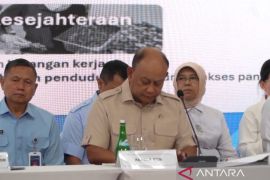The government raised the price of LPG in 12-kilogram cylinders by Rp1,500 a kilogram to curb state oil and gas company Pertamina`s losses from the sale of non-subsidized LPG.Jakarta (ANTARA News) - As expected, consumers are switching to subsidized liquefied petroleum gas (LPG) in three-kilogram cylinders following the governments recent decision to increase the price of same gas supplied in 12-kilogram cylinders.
The increase, which came into effect on September 10, has sparked a high demand for and a lack of supply of LPG in three-kilogram cylinders in many parts of Indonesia.
The government raised the price of LPG in 12-kilogram cylinders by Rp1,500 a kilogram to curb state oil and gas company Pertaminas losses from the sale of non-subsidized LPG. With the increase, the average price of LPG in 12-kilogram cylinders of Pertamina went up from Rp6,069 to Rp7,569 per kilogram.
However, the increase is still far from the actual price of more than Rp10 thousand per kilogram, so Pertamina will increase the price by another Rp1,500 per kilogram on January 1, 2015, and will raise this further by same amount every six months until it reaches the actual price.
Trader Dayat in the Riau provincial capital of Pekanbaru said he found it hard to get LPG in three-kilogram cylinders and his shops were no longer selling subsidized LPG.
"I have asked a number of distributors, but the stock is exhausted. Stocks might come again in a few days after the price of the non-subsidized gas is increased," he added.
In the East Java district of Jember, consumers of LPG in 12-kilogram cylinders have also switched to using subsidized LPG because of the price increase.
"I have sold my 12-kilogram LPG cylinder to an agent and switched to the smaller cylinders to save on household expenditure," Yeni Wulandari, a company employee, said here on Tuesday.
The increase in the price of non-subsidized LPG by Rp1,500 per kilogram or Rp18-20 thousand per cylinder has been burdensome to the public, with the government having already raised the electricity tariff a few weeks ago, Wulandari noted.
Irawati, a housewife who is also a resident of the district, said she made the switch a few days ago. "I have stopped using my 12-kilogram LPG cylinder and have bought more than two three-kilogram LPG cylinders to deal with the shortage of subsidized LPG as demand rises," she said.
The increase has shocked housewives and owners of small and medium enterprises who have been using LPG in 12-kilogram cylinders, Irawati added.
Purnomo, an employee of LPG agent PT Obor Besuki Perdana, said the sale of LPG in 12-kilogram cylinders had dropped to 50 percent in the wake of the government decision to raise its price.
In Jakarta, several food traders have also stopped using LPG in 12-kilogram cylinders to save on expenditure.
"We have made the switch because in the smaller cylinder, the gas is cheaper," food seller Sansan said in Pasar Baru area, Central Jakarta, on Monday.
He said the price disparity between LPG in 12-kilogram and three-kilogram cylinders compelled him to make the change. The increase has also prompted some retailers to raise the price of LPG sold in three-kilogram cylinders from Rp17 thousand to Rp19 thousand. "The price has increased since last month," food seller Sumarni said.
Maya Novita, director of LPG distributor PT Dwi Karya Mandala in Pasar Rebo, East Jakarta, said demand for subsidized LPG surged in the wake of the price increase. "Normally, we sell 500 cylinders in a day, but now they are sold out by noon," Novita noted.
In contrast, the sale of LPG in 12-kilogram cylinders fell from 850 units to an average of 400 units per day, she added.
The Gianyar district industry and trade office in Bali has been monitoring the distribution of LPG in thee-kilogram cylinders following the increase.
"We conduct a spot inspection to ensure the availability of subsidized LPG in three-kilogram cylinders in the market," Wayan Suamba, head of the industry and trade office, said on Monday.
Hanung Budya, Pertamina marketing and commerce director, predicted on Tuesday that only two percent of consumers of LPG in 12-kilogram cylinders would switch to subsidized LPG following the increase, and that the switch would be temporary.
He added that the switch would not lead to the consumption of subsidized LPG in three-kilogram cylinders in excess of the quota set in the revised 2014 state budget.
Pertamina anticipated the switch by applying the system of monitoring LPG in three-kilogram cylinders, called simol3k. "By applying simol3k, we can ensure the distribution of subsidized LPG from 3,400 agents to 143 thousand sub-agents nationwide," Budya said.
Gigih Wahyu Hari Irianto, Pertamina deputy president for LPG and gas products, said consumers of LPG in 12-kilogram cylinders switched to LPG in 3-kilogram cylinders only for one month, after the company raised the price of non-subsidized LPG last January.
"This time around, they will revert to using LPG in 12-kilogram cylinders more quickly than expected, as we had familiarized the public with the price increase since last January," he added.
The House of Representatives (DPR) Commission VII agreed at its meeting with acting Energy and Mineral Resources Minister Chairul Tanjung on Monday to set the quota of LPG in three-kilogram cylinders in the draft 2015 state budget at 5.766 million tons, or 15 percent more than the quota of 5.013 million tons in the revised 2014 state budget.
The increase is the result of a rise in the number of users of LPG in three-kilogram cylinders due to the kerosene-to-LPG conversion program, a 23 percent increase in demand from micro industry and the population growth rate of 1.38 percent.
Tanjung said the price disparities have made the switch inevitable and in the future, the government would be building more urban gas networks to bring down gas subsidy.(*)
Reporter: Suharto
Editor: Heru Purwanto
Copyright © ANTARA 2014











